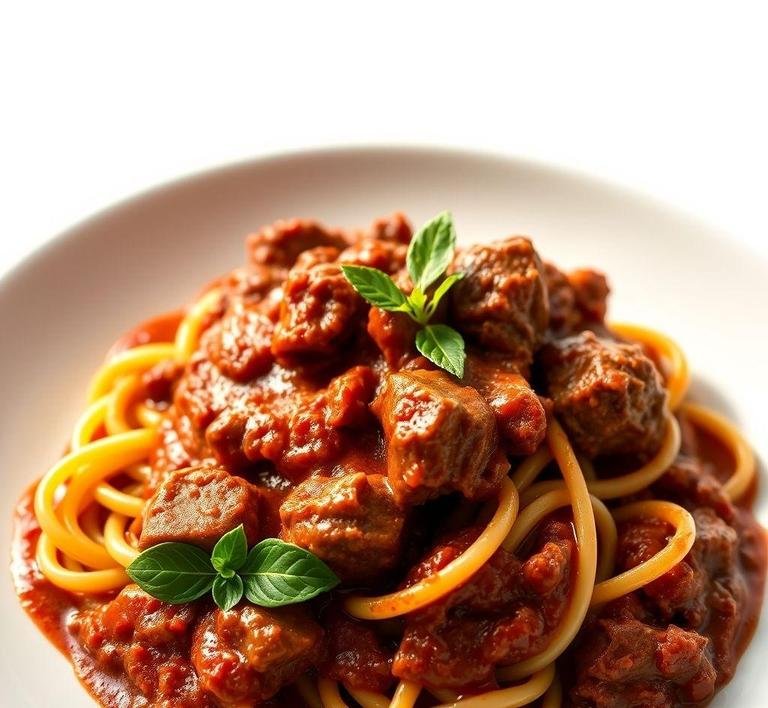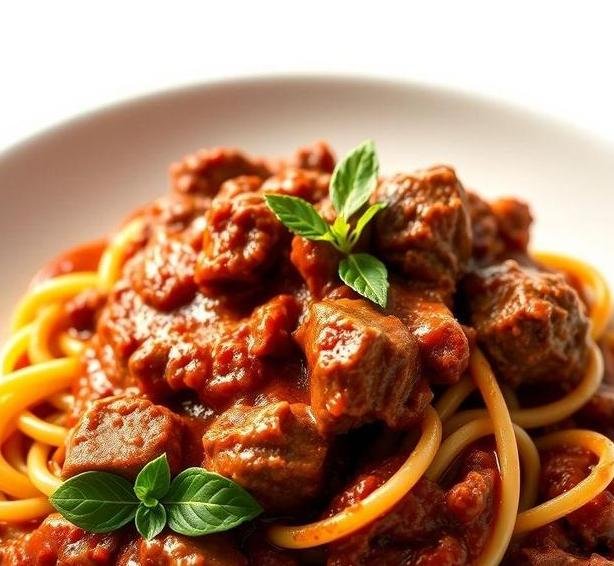Mary Berry, the queen of British home cooking, is renowned for her practical yet deeply flavorful dishes, and her take on beef ragu is no exception. This version of ragu is a rich, savory, slow-cooked meat sauce made with tender beef, robust red wine, aromatic vegetables, and a luscious tomato base. It’s often served over pasta – think pappardelle, tagliatelle, or even spaghetti – making it a deeply satisfying comfort food, perfect for a weekend dinner or a family gathering.
Unlike a quick meat sauce, this ragu is all about layering flavors and giving it time to develop a melt-in-the-mouth texture that clings to pasta in all the right ways. Mary Berry’s signature touch? Simplicity with elegance. She balances the richness of the beef and wine with subtle herbs and a kiss of sweetness from tomatoes, creating a dish that feels both rustic and refined.
Mary Berry’s Beef Ragu Recipe
Ingredients Needed

Here’s a rundown of everything you’ll need to recreate Mary Berry’s Beef Ragu. The ingredients are straightforward, but each plays an important role in building the depth of flavor.
For The Ragu
- 750g stewing beef (such as chuck or brisket), cut into small chunks
- 2 tbsp olive oil – for browning and sautéing
- 1 onion, finely chopped
- 2 carrots, finely diced
- 2 celery sticks, finely diced
- 2 garlic cloves, minced
- 2 tbsp plain flour – to help thicken the sauce
- 150ml red wine – use a robust variety like Chianti or Merlot
- 300ml beef stock – ideally homemade or a high-quality store-bought version
- 400g tin of chopped tomatoes
- 2 tbsp tomato purée
- 1 tsp sugar – balances the acidity of the tomatoes
- 2 bay leaves
- 1 tsp dried thyme or Italian herbs
- Salt and black pepper, to taste
Optional (but Highly Recommended)
- A small piece of Parmesan rind – adds umami depth during the simmering process
- Fresh parsley or basil for garnish
- Grated Parmesan for serving
Equipment Needed
You don’t need any fancy gadgets here – just good, solid kitchen essentials:
- Large heavy-based saucepan or Dutch oven – for browning and simmering
- Wooden spoon – for stirring
- Chopping board and sharp knife – for prepping your vegetables and meat
- Measuring jug – for your stock and wine
- Tongs or a slotted spoon – to handle the beef
- Ladle – for serving the sauce
- Pasta pot – if you’re cooking pasta to go with it
- Colander – for draining pasta
- Grater – for the finishing touch of Parmesan
Instructions To Make Mary Berry’s Beef Ragu
Here’s where the magic happens. Let’s take it step by step, so you get that rich, velvety ragu every time.
1. Prepare The Base
Heat the olive oil in your large saucepan or Dutch oven over medium-high heat. Once hot, add the beef in batches (don’t overcrowd the pan), and brown it on all sides. This searing step locks in flavor, so don’t skip it. Once browned, remove the beef with a slotted spoon and set it aside.
2. Soften The Vegetables
In the same pan, add a bit more oil if needed and lower the heat slightly. Toss in the chopped onions, carrots, and celery – the holy trinity of flavor known as a soffritto. Cook gently for about 10 minutes until the vegetables are soft and slightly golden. Stir in the garlic and cook for another minute or so, just until fragrant.
3. Thicken The Mixture
Sprinkle the flour over the vegetables and stir well to coat. This step helps the sauce thicken as it simmers. Cook for another 2 minutes to get rid of the raw flour taste.
4. Add The Liquids And Tomatoes
Return the beef to the pot. Pour in the red wine, letting it bubble up and reduce slightly – this deglazes the pan and infuses the meat with rich flavor. Then, stir in the beef stock, chopped tomatoes, tomato purée, sugar, herbs, bay leaves, and season generously with salt and pepper. If using a Parmesan rind, now’s the time to pop it in.
5. Slow Cook To Perfection
Bring the mixture to a gentle simmer. Cover the pan with a lid and let it cook low and slow for at least 2½ to 3 hours, stirring occasionally. The beef should become fall-apart tender, and the sauce should thicken beautifully. If it looks too thick, you can add a splash more stock or water.
6. Serve And Enjoy
Once ready, remove the bay leaves (and Parmesan rind, if used). Adjust the seasoning, toss with freshly cooked pasta, and finish with a generous grating of Parmesan and a sprinkle of fresh herbs.
Tips And Tricks
Want to elevate your ragu game? Here are some pro tips straight from the home cook’s playbook:
- Go for marbled beef: Cuts with more fat, like chuck or brisket, give you that luxurious mouthfeel. Lean cuts can turn dry.
- Use real wine: Cooking wine won’t give the same depth. Choose something drinkable that you wouldn’t mind sipping as the ragu simmers.
- Cook low and slow: This isn’t a quick fix. Letting it simmer for a long time ensures the beef breaks down and the flavors meld beautifully.
- Batch and freeze: Ragu freezes wonderfully. Make a double batch and freeze half for an easy dinner later.
- Ragu the next day: Like many stews and sauces, this actually tastes even better the next day. Consider making it ahead.
- No wine? No problem: You can sub in a mix of more beef stock with a dash of balsamic vinegar or Worcestershire sauce for added depth.
Mary Berry’s Beef Ragu is a classic dish with soul – it’s about taking simple ingredients and coaxing out their best flavors through patience, technique, and a touch of love. Whether you’re planning a cozy night in or a special dinner with friends, this ragu is bound to impress. Its rich, meaty sauce clinging to ribbons of pasta, topped with sharp Parmesan and perhaps a glass of red on the side, is nothing short of divine.
So go ahead – roll up your sleeves, let your kitchen fill with the aroma of slow-cooked goodness, and treat yourself to one of Mary Berry’s finest culinary creations. You won’t regret it.
Easy Recipe Variations For Mary Berry’s Beef Ragu

Mary Berry’s beef ragu is already a beautifully layered dish – deeply savoury, tender, and full of comforting warmth. But what’s truly wonderful about this recipe is how adaptable it is. Whether you’re tweaking the ingredients to suit dietary needs, personal tastes, or just working with what you have in the pantry, this ragu can wear many hats.
1. Vegetable-Forward Ragu
If you’re aiming to sneak in a few extra servings of vegetables or you’re catering to a vegetarian crowd, try bulking up the ragu with earthy mushrooms, diced zucchini, or finely chopped bell peppers. Replace the beef with lentils or a plant-based mince, and you’ve got a robust vegetarian option that still feels hearty. A splash of soy sauce or Marmite can add back some umami to replace the meaty depth.
2. Spicy Italian Twist
For those who love a little fire in their food, you can give the classic Mary Berry ragu a Calabrian twist. Add crushed red pepper flakes, a teaspoon of smoked paprika, and perhaps a few chopped sun-dried tomatoes for sweetness and tang. You can also stir in a splash of red wine for depth – something like Chianti or Sangiovese will elevate the sauce beautifully.
3. Creamy Tomato Ragu
Want a silkier finish to your sauce? Swirl in a touch of mascarpone or heavy cream during the last few minutes of simmering. It adds a luscious mouthfeel and balances the acidity of the tomatoes perfectly. This variation pairs beautifully with soft egg-based pasta like tagliatelle or even a pillowy gnocchi.
4. Slow Cooker Magic
Don’t have hours to watch the stove? Adapt the ragu for the slow cooker. Brown the beef and soften the onions first, then toss everything into the slow cooker and leave it on low for 6-8 hours. The result? Meltingly tender beef and a sauce so rich it clings lovingly to every bite of pasta.
5. Wine-Free Option
If you prefer to skip the wine but don’t want to lose complexity, try substituting with a mixture of beef stock and a tablespoon of balsamic vinegar or Worcestershire sauce. These give the sauce body, tang, and richness without any alcohol.
Storing Leftovers
The beauty of beef ragu lies not just in its flavour but also in how well it stores. In fact, many would argue it tastes even better the next day, once the flavours have had more time to mingle.
In The Refrigerator
Once your ragu has cooled completely, transfer it to an airtight container. It will keep well in the fridge for up to 4 days. When you’re ready to enjoy it again, reheat gently in a saucepan over medium-low heat, adding a splash of water or broth to loosen it if needed.
In The Freezer
This dish is an ideal candidate for freezing – perfect for busy weeknights when you need something hearty and homemade. To freeze, spoon the cooled ragu into freezer-safe containers or heavy-duty freezer bags (squeeze out excess air before sealing!). Label with the date, and store for up to 3 months. When ready to use, defrost overnight in the fridge and reheat slowly, stirring occasionally to prevent sticking.
Pro Tip: If You’re Planning On Serving The Ragu With Pasta Later, Freeze The Sauce Separately From The Pasta. This Keeps The Textures Perfect When It’s Time To Reheat And Serve.
What To Eat With Mary Berry’s Beef Ragu?
The ragu itself is rich, meaty, and deeply savoury, so choosing accompaniments that highlight or contrast its flavours can take the meal to the next level.
1. The Classic Pairing: Pasta
You can’t go wrong with a generous tangle of tagliatelle, pappardelle, or fettuccine. These wider noodles cling to the sauce, capturing every bit of flavour. For a more rustic touch, try homemade egg pasta or even polenta.
If you’re going the pasta route, remember to cook it al dente – you want it to hold up under the weight of the sauce. Also, toss the pasta directly into the sauce for a minute before serving so it absorbs all that goodness.
2. A Warming Bed Of Polenta
Soft, creamy polenta makes a fantastic alternative to pasta. It’s mild, but it soaks up the ragu beautifully. Finish with a drizzle of olive oil and a sprinkle of Parmesan, and you’ve got a dish that feels luxurious yet comforting.
3. Crusty Bread And A Salad
Sometimes, simplicity wins. Serve your ragu with a thick slice of crusty bread (ideally toasted or grilled with a brush of garlic-infused olive oil) and a crisp green salad. Peppery arugula, shaved fennel, or a lemon-dressed spinach salad cuts through the richness of the sauce and adds refreshing contrast.
4. Cheese, Glorious Cheese
Don’t shy away from a finishing flourish. Freshly grated Parmesan or Pecorino Romano is a must – but you could also try a dollop of ricotta on top for a creamy, cooling complement.
5. Wine Pairings
If you’re enjoying your ragu in a more leisurely setting, pair it with a bold red wine. A Chianti Classico, Barolo, or even a rich Zinfandel echoes the depth of the dish and rounds out the meal beautifully.
Conclusion
Mary Berry’s beef ragu is far more than a simple meat sauce – it’s a celebration of slow-cooked flavour, culinary tradition, and warm, homey satisfaction. Whether you keep to her classic approach or branch out with creative twists, this dish is endlessly versatile and deeply rewarding. From weeknight dinners to cosy Sunday lunches, it adapts beautifully to your mood and menu. And with clever storage and thoughtful pairings, you can make the most of every savory, saucy bite.
So, next time you find yourself craving comfort food with a touch of elegance, remember: a pot of beef ragu might just be all you need.
FAQs
What Are The Key Ingredients For Mary Berry’s Beef Ragu?
Mary Berry’s beef ragu requires a combination of high-quality beef (such as braising steak or chuck), onions, garlic, carrots, celery, and tomatoes. It also includes red wine, beef stock, and a variety of herbs like thyme and bay leaves. The ingredients are cooked slowly to create a rich, savory sauce.
How Long Should I Cook Mary Berry’s Beef Ragu For?
The beef ragu should be cooked slowly for about 2 to 2.5 hours to allow the beef to become tender and the flavors to meld together. It’s essential to cook it on a low heat to avoid drying out the meat and to develop the rich depth of flavor that is characteristic of a great ragu.
Can I Make Mary Berry’s Beef Ragu In Advance?
Yes, Mary Berry’s beef ragu can be made in advance. In fact, it often tastes even better the next day as the flavors have more time to develop. After cooking, allow the ragu to cool and store it in an airtight container in the fridge for up to 2 days. It can also be frozen for up to 3 months, just reheat thoroughly before serving.


